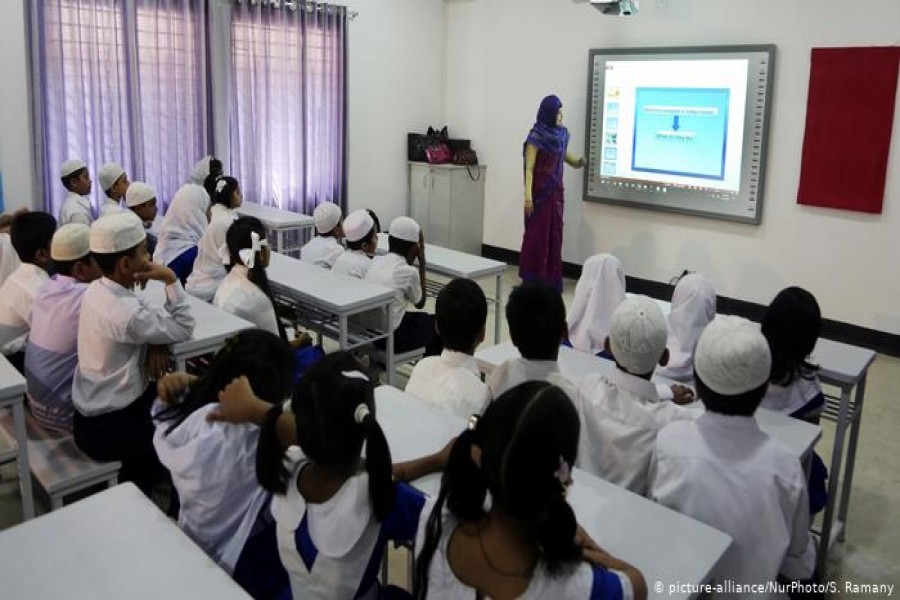After COVID-19, no internet means no school for Bangladesh's rural children

Published :
Updated :

Nine-year-old Subarna Akhter Sathi spends most of her days with friends at a local playground in Brahmanbaria, an eastern district of Bangladesh. On regular days, Subarna would have been going to school and preparing assignments, but most institutions have been shut ever since Bangladesh went into lockdown in late March to contain the COVID-19 outbreak.
"My daughter has lost interest in studying after the school's closed," Subarna's mother, Roksana Begum, told DW. "She wakes up late and plays all day."
The South Asian country has over 3,68,000 coronavirus cases with 5,348 deaths.
The nationwide lockdown on March 26 brought everything in the country to a near standstill, brought everything in the country to a near standstill, forcing 38.6 million students of all education levels out of school. Though the government eased lockdown measures after two months, all education institutions are expected to remain closed until October 31.
City schools trump COVID-19
There are currently an estimated 21.6 million students enrolled in primary and pre-primary schools, 13 million in secondary schools, and 4 million studying at the tertiary level - at universities and colleges. According to the Ministry of Education, 76 per cent of Bangladesh's secondary schools are located in rural areas and around 60 per cent of primary school children attend government-run schools – also mostly in rural areas.
"Rural schools lack infrastructure including digital equipment, qualified teachers and hygiene facilities," Mahtab Uddin, a research fellow at the non-government organisation South Asian Network on Economic Modeling (SANEM) said, adding that this has hindered online schooling efforts.
Bangladesh's private schools, on the other hand, have been quick to adopt online learning methods following the lockdown. Lectures are delivered through social media platforms such as WhatsApp, Facebook, and YouTube.
Mostly located in urban areas, these schools are attended by the country's upper income group. Not only are the schools better equipped and prepared, students are also more likely to have access to the required technologies at home, while parents are usually computer literate.
A long way to go
Meanwhile, the Bangladeshi government has also asked state-owned radio and television stations to broadcast recorded and live lectures in efforts to address the disruption of schooling due to the pandemic. Teachers are also giving students course-related advice via mobile phones, Akram Al Hossain, the senior secretary of Bangladesh’s Primary and Mass Education Ministry said.
While the government’s efforts seem to have been successful in reaching the country's urban students, poor internet connection and a lack of digital devices mean many rural students have no access to the programmes.
Universities have also started delivering lectures through online platforms like Zoom, but even in this case, lack of technical infrastructure among some groups of students has been a hurdle.
"We began to deliver lectures online amid challenges such as students' limited access to digital equipment and their lack of technical capacities," said Mohammad Sahid Ullah, a professor at Chittagong University, one of the country's largest universities with more than 25,000 students.
"Many faculty members show no interest in delivering online lectures, exacerbating the limitations," he explained, adding that students' presence could also never be confirmed.
Dwindling finances
In a recent study, Bangladesh Rural Advancement Committee (BRAC), a non-governmental organization, found that 54 per cent of Bangladesh’s rural households lacked internet facilities while 59 per cent did not have access to smartphones.
According to Chittagong university's Sahid Ullah, the government will have to assess factors like access to technology, literacy and capability of the students before designing an online communication strategy.
In addition to limited infrastructure, people living in rural areas, like nine-year-old Subarna and her mother Roksana have also had to grapple with lack of money in the last months. Buying a smartphone for Subarna's school work is definitely not an option for her.
"My husband’s income went down in recent months due the coronavirus problem, which caused a great deal of suffering in our life," Begum said, adding that buying smartphone data "in this crisis" would only worsen her economic woes.


 For all latest news, follow The Financial Express Google News channel.
For all latest news, follow The Financial Express Google News channel.